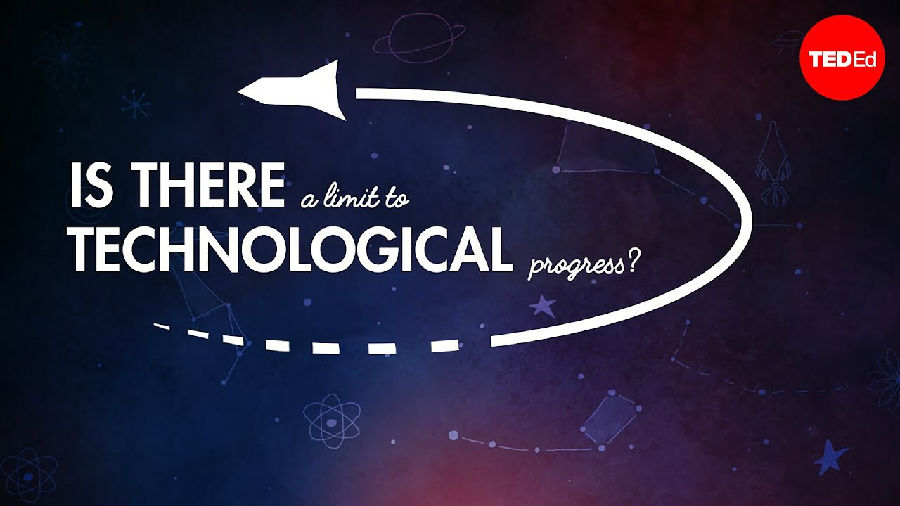(单词翻译:单击)
Many generations have felt they've reached the pinnacle of technological advancement,
许多代的人都曾觉得他们的科技发展已达到顶端,
yet look back 100 years, and the technologies we take for granted today would seem like impossible magic.
但放在100年前,我们现在拥有的日常科技简直就是不可思议的魔法。
So will there be a point where we reach an actual limit of technological progress?
那么,科技发展的极限真的存在吗?
And if so, are we anywhere near that limit now?
如果存在,现在的我们离它又有多远呢?
Half a century ago, Russian astronomer Nikolai Kardashev was asking similar questions
半个世纪前,俄罗斯宇航员尼古拉·卡尔达肖夫问过同样的问题,
when he came up with a way to measure technological progress, even when we have no idea exactly what it might look like.
他创造出了衡量技术进度的办法,虽然当时我们对它没有任何概念。
Anything we do in the future will require energy, so Kardashev's scale classifies potential civilizations,
我们未来所有的活动都需要能量,所以科尔达肖夫指数把潜在的文明,
whether alien civilizations out there in the universe or our own, into three levels based on energy consumption.
不管是宇宙中的外星文明还是我们自己的文明,都按照能源消耗分成了三类。
The tiny amount of energy we currently consume pales next to what we leave untapped.
比起未使用的能源,我们已消耗的能量其实微不足道。
A Type I, or planetary civilization, can access all the energy resources of its home planet.
第一类,又名行星系文明,可以充分使用母行星的所有能源。
In our case, this is the 174,000 terawatts Earth receives from the Sun.
对人类来说,就是地球从太阳吸收到的17.4万太瓦的能量。
We currently only harness about 15 terawatts of it, mostly by burning solar energy stored in fossil fuels.
我们目前用燃烧化石燃料的方法采集到的太阳能,只消耗了其中的15太瓦。
To approach becoming a Type I civilization,
想要更接近第一类文明,
we would need to capture solar energy more directly and efficiently by covering the planet with solar panels.
我们需要通过安装太阳能板来更直接有效地吸收太阳能。
Based on the most optimistic models, we might get there within just four centuries. What would be next?
根据最乐观的数据模型,这个目标我们四个世纪内就可以达到。那接下来呢?
Well, the Earth only gets a sliver of the Sun's energy, while the rest of its 400 yottawatts is wasted in dead space.
事实上,地球只得到了其中极少的能量,剩下的400尧它瓦太阳能都浪费在了虚空的宇宙中。
But a Type II, or stellar civilization, would make the most of its home star's energy.
但是第二类,恒星系文明,可以把母恒星的能量利用到极致。
Instead of installing solar panels around a planet, a Type II civilization would install them directly orbiting its star,
我们可以把太阳能板安装到能量源星球周围,而不是在围绕它的行星上,
forming a theoretical structure called a Dyson sphere.
这样就可以形成一个名叫戴森球的理论结构。
And the third step? A Type III civilization would harness all the energy of its home galaxy.
那第三步呢?第三类文明可以采集整个母星系的能量。

But we can also think of progress in the opposite way. How small can we go?
但我们也可以用相反的方式来拟构发展。我们如何可以到达最小的维度?
To that end, British cosmologist John Barrow classified civilizations by the size of objects they control.
英国宇宙学家约翰·巴洛利用文明所控制的物质的大小来对其进行分类。
That ranges from mechanical structures at our own scale,
从人类尺度内的机械结构,
to the building blocks of our own biology, down to unlocking atoms themselves.
到人类生物学维度的细胞,再到原子的结构解析。
We've currently touched the atomic level, though our control remains limited.
虽然我们接触到了原子层级,但我们对其的控制仍然有限。
But we potentially could go much smaller in the future.
但是我们将来可能会接触到更小的层级。
To get a sense of the extent to which that's true, the observable universe is 26 orders of magnitude larger than a human body.
一个更真实的比较是,能观测到的宇宙是人体体积的10的26次方倍。
That means if you zoomed out by a factor of ten 26 times, you'd be at the scale of the universe.
意思是,如果把你每次放大10倍,放大26次,你的体积就跟宇宙一样大了。
But to reach the minimum length scale, known as the Planck length, you would need to zoom in 35 times.
但为了达到最小长度,即普朗克长度,你需要缩小35次。
As physicist Richard Feynman once said, 'There's plenty of room at the bottom.'
就如物理学家理查德·费曼所言:“微观世界仍有很多空间。”
Instead of one or the other, it's likely that our civilization will continue to develop along both Kardashev and Barrow scales.
我们未来的文明发展并不会局限于其一,而是依照卡尔达舍夫与巴洛指数共同发展。
Precision on a smaller scale lets us use energy more efficiently
在小层级的精确控制可以让我们更有效地利用能源,
and unlocks new energy sources, like nuclear fusion, or even antimatter.
并开发新的能源,比如核聚变,或者甚至是反物质。
And this increased energy lets us expand and build on a larger scale.
而更多的能源将会允许更大规模的发展与建设。
A truly advanced civilization, then, would harness both stellar energy and subatomic technologies.
一个真正先进的文明可以同时采集恒星能量和亚原子能。
But these predictions weren't made just for us humans.
但这些预言并不只适用于人类。
They double as a possible means of detecting intelligent life in the universe.
它们同时也可能成为探测宇宙中智慧生命的方法。
If we find a Dyson sphere around a distant star, that's a pretty compelling sign of life.
如果我们在远处的某颗恒星周围找到了戴森球,那很有可能标志着着生命的存在。
Or, what if, instead of a structure that passively soaked up all the star's energy, like a plant,
或者,外星人可能没有建造一个像一棵植物那样被动吸取能量的结构体,
an alien civilization built one that actively sucked the energy out of the star like a hummingbird.
而是建造了一个主动从恒星吸取能量的结构体,像一只蜂鸟。
Frighteningly enough, we've observed super dense celestial bodies
可怕的是,我们曾观测过超高密度的天体,
about the size of a planet that drain energy out of a much bigger star.
大小如一个行星,却从一个大得多的恒星攫取了所有的能量。
It would be much too premature to conclude that this is evidence of life in the universe.
但这还不足够证明宇宙里还有其他生命。
There are also explanations for these observations that don't involve alien life forms.
对这种现象也有一些其他解释,它们并不涉及外星生命形式。
But that doesn't stop us from asking, 'What if?'
但这并不会阻止我们提出疑问:“假如真的有呢?”


